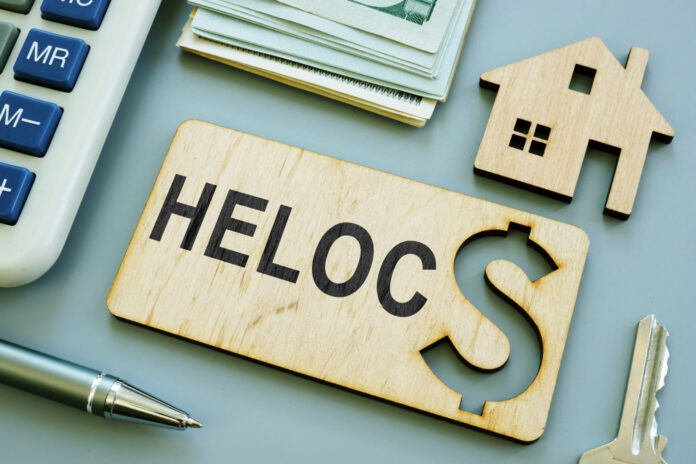Lenders offer HELOCs, defined as home equity loans, that let you borrow money when you need it and pay it back over time at a variable rate. One uses HELOCs when they need more time to pay off current financial obligations or need money to continue home renovations or additions. HELOCs act more like credit card loans as they are easily accessible. However, you’ll need a strong credit score, a low debt-to-income ratio, and valuable tappable equity in your home to get the best rates. Once all that checks out, your loan can be processed in record time.
How does a HELOC work?
HELOC offers you the freedom to borrow money against your house equity, repay and borrow again. It operates similarly to a credit card in that you borrow money as much as you can against your spending limitations. The interest rates on most HELOCs are adjustable. It implies that if the base interest rates or fall, so will the interest rate on your HELOC. The lender will start with an index rate and then apply a markup based on your credit profile to determine your rate. The smaller the markup, the better your credit score is. The markup is known as the margin.
Your home is the security of your credit, which means that if you don’t pay your credit card bill, the lender can take your home. While taking a loan using your home might seem risky, it is worth it as this type of credit has a seemingly low-interest rate compared to other types of loans. The best part is that the interest may be tax-deductible. The amount of credit you qualify for increases as you repay your outstanding bill. Meaning that you can borrow against it again if needed.
Moreover, you can borrow as little or as much as you need during your draw period (usually ten years), up to the credit limit you set at closing. The payback period begins after the draw period ends (usually 20 years). However, you should make monthly principal and interest payments on your remaining balance throughout this time. However, because you make interest-only payments throughout the draw period, the payments during the payback term might be more than double.
HELOC FAQs
How much money can one borrow?
HELOC allows one to borrow a loan of up to 85% of your home’s value less the credit owed. The eligibility of your loan depends on your credit score, employment history, monthly income, and monthly debts. When you open an account, enquire from the credit officer if there is a minimum withdrawal requirement. Also, do not forget to ask about spending money from the credit line using checks, credit cards, or a combination of the two. It is necessary to determine if your home equity plan has a specific draw period when you can make any withdrawals.
What are their interest rates?
You will need to ask about the interest rates available as most HELOCs offer a range of interest rates. At first, rates may translate into lower monthly payments, but the fees may change. Fixed interest rates can be a little higher in the beginning than variable rates. In contrast, monthly payments may remain consistent throughout the credit period. Check and compare the terms if you opt for the variable rates. Examine the periodic interest rate cap, as it limits the number of interest rate changes that may arise. Also, look into the interest cap, which is a limit on interest rate adjustments during the life of the loan. Sometimes, lenders offer a temporary discount rate and if you qualify, find out what charges you are to incur when loan term ends and how much more your payment will be.
What are the upfront closing costs?
You’ll be effectively paying for the same things you were when you obtained your first mortgage once you get a home equity line of credit. An application payment, title search, appraisal, lawyers’ costs are among them. Even if you only use a small portion of your credit line, these fees can soon pile up and increase your payback amount. Consult your lenders to see if they will cover part of these costs.
What are the continuing costs?
In addition to upfront closing fees, some lenders ask you to pay a service charge throughout the loan. Annual membership or participation fees may also be a part of the ongoing expenditures, which you should clarify. Each time you borrow money, you will be charged a transaction fee. These fees are applied to the total loan amount.
What are the repayment terms during the loan?
You may need to figure out how frequently your payments may vary. Check whether you’re repaying the principal as well as the interest or only the interest. It would help to inquire about late payment penalties, payback terms after the loan, and the situations under which the lender can declare you a defaulter.
Three-day cancellation rule
Before signing on the dotted line, make sure you read all of the loan documentation thoroughly. You have three days under federal law to review a signed credit arrangement and cancel it without a penalty. You have the rights to cancel the contract for any reason, but only if you are using your primary residence. Correspondingly, you have until the third business day to terminate the credit transaction under the right to cancel provision. You must mail or file electronically the notice by the third day’s midnight excluding Sundays and legal public holidays. It would help if you let the lender know you have decided to cancel the contract. This cancellation process cannot be done via phone or face-to-face conversation. You can only cancel through the mail or electronically.
